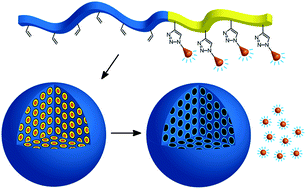The design of efficient drug delivery vehicles has been a long standing challenge in polymer and materials science. A variety of polymeric platforms have been developed in recent years based on an array of different structures including micelles, dendrimers, hydrogels and encapsulant nanoparticle. Exploiting the concept of dispersion self-assembly of soft materials in the drug delivery arena requires the incorporation of multiple functionalities into a judiciously designed BCP platform. In this paper, Hawker and co-workers reported the design of nanoparticles made of well-defined block copolymers (BCPs) containing an alkyne-functional, biodegradable polylactide (PLA) conjugated with azide-functional coumarin dyes, as a model drug, via copper catalyzed azide alkyne cycloaddition ‘click’ chemistry. Self-assembled nanoparticles with internal nanophase-separated morphologies were accessed by carefully controlling the composition of the BCPs and release of the covalently attached model payload was shown to occur under physiological conditions via the degradation of the PLA scaffold. These results demonstrated the potential of self-assembled nanoparticles as modular delivery vehicles with multiple functionalities, nanostructures, and compartmentalized internal morphology.
Functional block copolymer nanoparticles: toward the next generation of delivery vehicles by Maxwell J. Robb, Luke A. Connal, Bongjae F. Lee, Nathaniel A. Lynd and Craig J. Hawker, Polym. Chem., 2012, 3, 1618-1628.
To keep up-to-date with all the latest research, sign up for the journal’s e-alerts or RSS feeds or follow Polymer Chemistry on Twitter or Facebook.











